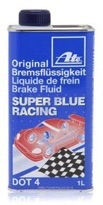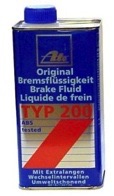
Published in the April 2011 issue of “Die Porsche Kassette”
The most powerful system in your car is also the most important and many times one of the most neglected.
I’m referring to your brakes, and in particular to the hydraulic fluid also known as brake fluid.
Why do I say that it’s the most powerful?
Many people think that the most powerful system in their car is their engine, which, in a Porsche, can develop 300+ HP and can accelerate the (3000+ lbs) car from 0 to 60 mph in less than 5 seconds.
But consider this: Your brakes have to decelerate your car much quicker!
A modern Porsche can go from 60 to 0 mph in just under 2 seconds. That makes the braking system much more powerful than your engine.
Why do I say that it’s one of the most neglected?
Because many, many people have never replaced the hydraulic fluid in their brakes.
Porsche recommends doing a complete flush every 2 years, but if you track your car you should flush prior to every event, because the boiling point of the fluid can drop to a potentially dangerous level due to moisture contamination and may not even meet the Federal requirements for brake fluid.

What exactly is brake fluid?
There are two basic types of brake fluid: silicone-based (DOT 5) and glycol-based (DOT 3, DOT 4, DOT 5.1). But there are also several classifications within those two types, based on their boiling points.
Silicone-based fluids are generally used in military-type vehicles, and cannot be used with ABS systems because they don’t lubricate the pump like a glycol-based fluid does, so we won’t mention them again.
Polyalkylene Glycol Ether - based fluid is what we have in our cars.
The Department of Transportation (DOT) classifies it based on it’s boiling point temperatures.

What is boiling point?
Wet boiling point is the minimum temperature at which the brake fluid will begin to boil when the brake system contains 3% water by volume in the system.
Dry boiling point is the temperature at which that brake fluid will boil with no water present in the system.
But if my system is closed, how can it get contaminated with moisture?
Well, glycol-based brake fluid is very hygroscopic. This means that it will aggressively absorb water from the moment the container is opened. Many manufacturers pack brake fluid under nitrogen to extend its shelf life. Brake fluid will absorb water through minute, even microscopic pores in brake hoses, lines and piston seals and when it is exposed to air. In South Florida, where the humidity level is usually very high the problem is exaggerated. Also, as caliper and brake line temperatures increase and then cool repeatedly, condensation occurs, leaving behind an increase in moisture.
How can moisture deteriorate the fluid?
Over time the moisture becomes trapped in the internal sections of calipers, lines, master cylinders, etc. Brakes generate heat because of the friction between the pad and the rotor and rotors can actually glow red at track events. When this trapped water reaches 212º F it turns into steam (water vapor). Many times air in the brake system is a result of water that has turned to water vapor. The build up of steam will create a higher pressure in the system, sometimes to the point that enough pressure is created to push caliper pistons into the brake pads. This will in turn generate brake drag as the rotor and pads make contact and will also create more heat in the system.
Water vapor (steam) is a gas. Gas is much more compressible than liquid. So, when you get enough water vapor in the system and you press the brake pedal hard, it will compress the water vapor before the pistons push the pads into the rotors, giving you a “mushy” pedal feel, or brake-fade.
So, which fluid is the recommended one?
There are several excellent brake fluids on the market which are suitable for Porsche brake systems. Obviously the Porsche-brand is what comes in our cars but many enthusiasts tend to switch to other brands such as ATE, Motul, Castrol, Brembo, AP, Pentosin or others due to availability, cost and or performance.







Because I replace my fluid so often (once per month – as I attend DEs and AXs on a regular basis) I personally use ATE Gold and ATE Super Blue. Both are the same except for the color. By alternating colors you can actually see when the new (fresh) color makes it through the system and that way you don’t use more than needed.
One liter of fluid is enough to completely flush the brake and clutch hydraulics in a Porsche.
What do I need to remember?
If fluid is changed often with fresh fluid it will contain very little water
Never use silicone-based fluids in your (ABS equipped) Porsche
Using racing fluid will increase the braking performance of your system
Never reuse fluid or mix brands
Use smaller fluid containers and discard remnants
When replacing fluid, flush the complete system
Immediately replace the reservoir’s cap following any maintenance
For more information on brake systems and more, please visit my website at: www.PedrosGarage.com.
Happy Porsche-ing,
© 2011 Technolab/PedrosGarage.com


